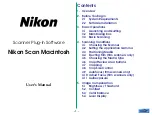
19
MPS4232
Section 3: Operation
Max Delay = (1/MPS Rate) * (Max Frames in Buffer) / 2)
Max Delay = (1/MPS Rate) * 32768 / 2)
Max Delay = 16384 / MPS Rate
Note: The buffer size in the MPS4232 is 32768 frames.
However, to handle delays in the network connection only
half should be used as a target delay. Thus 16384 frames
are the maximum frames to hold in the buffer.
Zero Offset Calibrations (CALZ)
The MPS’s software incorporates a zero offset correction
feature (Quick Zero or
). This feature provides a simple
and quick means to correct for the minor zero drift prob
-
lems inherent to piezoresistive sensors.
Because the MPS4232 does not have a calibration valve,
must be performed in a “wind-off” state (no
pressure applied to the module). At that point, with the
sensor at its natural zero differential state, any offset can
be read and recorded. This can then be factored into the
engineering unit conversion and mathematically removed
automatically within the MPS software. Quick Zero calibra
-
tions can be performed in under 10 seconds.
Due to the nature of the piezoresistive sensors used in
the MPS modules, it is recommended that a quick zero
calibration be performed at least daily. Performing a quick
zero more often will not cause any problems and is highly
encouraged. There are no issues using the quick zero cali
-
bration each time before data is collected. Keep in mind, if
the temperature of the module changes more than 5°C, a
fresh quick zero should be performed.
Zero offset corrections may become obsolete after several
hours or after the module has changed temperatures.
IEEE1588v2 Precision Time Protocol
The MPS is compliant with IEEE1588v2 Precision Time
Protocol (PTP). The MPS’s PTP engine can be configured as
follows:
•
Disabled
• Enabled as a PTP slave device
• Enabled as a PTP master device
When configured as a PTP slave device, the MPS will listen
for PTPv2 packets being multicasted on the network. This
allows for the MPS’s internal time and date to be set and
synchronized when a PTP Grandmaster is active on the
same network. This synchronization will also adjust the
internal scan rate of the module to pace with the PTP
Grandmaster time.
When the MPS4200 is configured as a PTP master device,
the MPS will multicast PTPv2 packets over the network,
similar to a PTP Grandmaster. The MPS will use its internal
time and date when multicasting these packets for synchro
-
nization. The MPS configured as a PTP master allows other
PTP enabled Scanivalve devices to be synchronized using
the internal time and date of the ‘master’ MPS device. This
synchronization on ‘slave’ devices will adjust the internal
scan rate of the ‘slaves’ to pace with the PTP Master.
Note: Only one PTP Grandmaster or PTP master can be
present on a network at any given time.
When the MPS is enabled as a ‘slave’ PTP device, the
MPS requires that announce packets are multicast on the
network.
Whether PTP is enabled or disabled, the
command will retrieve the current internal time of the
MPS. When the MPS’s PTP engine is disabled or enabled as
a PTP master, the MPS’s time and date can be manually set
using the
command.
Other PTP related commands, including PTP statistical
information, debug output, and setting the UTC offset, can
be referenced in the PTP Commands section under Section
PTP Triggered Scan
The IEEE1588 protocol allows MPS4200 units to start scan
-
ning at a preset time and date while keeping their data
samples time synchronized. This allows a user to synchro
-
nize the scan start time across multiple units. A scan
start time and date in the future can be configured in the
MPS4200 using the Scan Start Date (
) and Scan Start
Time (
) variables. After a
command is issued, the
MPS will enter scan mode but will not output data. Once
time has been met (based on the internal
time of the MPS/PTP Time), the time will trigger the MPS to
start releasing frames of data at the set internal rate. If
and
are set for a time in the past (based on the internal
command will execute a scan and
the MPS will release data immediately.
The following table describes a start scan time with two
MPS4200 units when setting
for a time in the
future.
Summary of Contents for MPS4232
Page 1: ...MPS4232 Miniature Pressure Scanner Hardware and Software Manual Software Version 1 00...
Page 2: ......
Page 3: ......
Page 6: ...INTENTIONALLY LEFT BLANK...
Page 12: ...6 MPS4232 Section 1 Specifications INTENTIONALLY LEFT BLANK...
Page 15: ...9 MPS4232 Section 1 Introduction Section 1 Specifications MPS4232 INTENTIONALLY LEFT BLANK...
Page 18: ...12 MPS4232 Section 2 Introduction INTENTIONALLY LEFT BLANK...
Page 33: ...27 MPS4232 Section 4 Hardware INTENTIONALLY LEFT BLANK...
Page 37: ...31 MPS4232 Section 5 Software INTENTIONALLY LEFT BLANK...
Page 51: ...45 MPS4232 Section 5 Software...
Page 81: ...75 MPS4232 Section 6 Maintenance INTENTIONALLY LEFT BLANK...
Page 90: ...84 MPS4232 Appendix INTENTIONALLY LEFT BLANK...
Page 94: ...88 MPS4232 Appendix D Software Revision Log Version 1 00 Initial Release...
















































